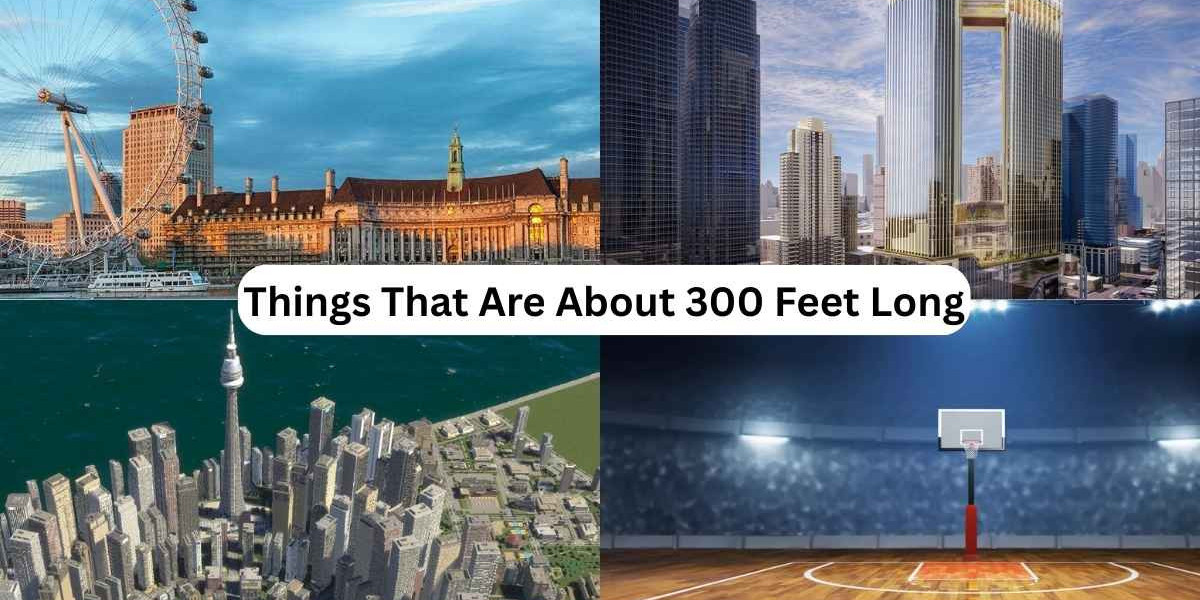When someone tells you, “It’s about 300 feet away,” do you immediately picture the distance in your mind? For many people, visualizing exactly how far 300 feet is can be tricky. It’s not a number we encounter daily, like a “mile” or a “yard.” Yet, 300 feet is a surprisingly useful measurement that appears in sports, architecture, nature, and even everyday life.
In this article, we’ll break down what 300 feet looks like, compare it to familiar objects, explain its significance in various fields, and give you plenty of fun, real-world examples.
1. Understanding the Measurement: What Is 300 Feet?
Before we can visualize 300 feet, let’s first understand the basics:
Feet (ft) is a unit of length primarily used in the United States and a few other countries.
1 foot = 12 inches.
1 yard = 3 feet.
1 mile = 5,280 feet.
So:
300 feet = 100 yards (exactly the length of an American football field, without end zones).
300 feet = about 91.44 meters in the metric system.
When you hear “300 feet,” think of it as a little less than the length of a soccer field, or about the height of a 30-story building if turned vertically.
2. Everyday Comparisons for 300 Feet
To truly “see” 300 feet in your mind, it helps to compare it with common objects or spaces. Here are some relatable comparisons:
A. Football Fields
In American football:
The playing field (goal line to goal line) is 100 yards — exactly 300 feet.
Add the end zones and it becomes longer, but the main part of the field itself is your perfect 300-foot example.
B. A 30-Story Building
On average:
One story of a building is roughly 10 feet high.
So, a 30-story building would be about 300 feet tall.
This makes it easier to imagine if you’ve seen a tall hotel or office tower.
C. City Blocks
In many U.S. cities, a standard city block is about 300 to 325 feet long.
Walking one block in certain neighborhoods can give you the feel of a 300-foot distance.
D. Airplanes
A Boeing 747 has a wingspan of about 211 feet, so slightly shorter than 300 feet.
The Airbus A340-600, one of the longest passenger planes, is about 247 feet long — close to 300 feet when combined with part of the tarmac.
E. Ships
Many medium-sized cruise ships or naval destroyers measure between 250 and 350 feet in length, making them great visual references.
3. Sports and Recreation Examples
Sports fields and equipment often match or come close to 300 feet.
A. Baseball Outfield
In many professional baseball stadiums, the distance from home plate to the outfield fence down the foul lines is between 300 and 330 feet.
That’s why home runs look impressive — they travel at least that far!
B. Soccer Fields
While a standard professional soccer field is longer than 300 feet (usually 330–360 feet), half the field is close to the 300-foot mark.
C. Track and Field
Running 300 feet is roughly 91 meters — just under the length of a 100-meter dash.
4. Nature and Landscape Comparisons
A. Tall Trees
The tallest trees in the world, like California’s redwoods, can exceed 300 feet in height.
Imagine standing at the base of one and looking straight up — that’s your 300-foot vertical distance.
B. Waterfalls
Some waterfalls, such as Oregon’s Multnomah Falls, have drops close to 300 feet.
This shows how striking the distance can be in natural landscapes.
C. Hills and Elevations
Hiking trails often list “elevation gain,” and 300 feet is a noticeable but manageable climb for most hikers.
5. Driving and Travel Perspective
300 feet doesn’t sound like much when you’re in a car, but it still matters.
At 60 mph, you cover 300 feet in just about 3.4 seconds.
This is one reason why safe following distances in driving schools often recommend at least 3 seconds behind the car in front — at highway speeds, that’s about 300 feet.
6. Aviation and Flying Perspective
Pilots and aviation professionals measure distances in feet, especially altitude.
300 feet in the air means you’re about the height of a tall observation tower.
Helicopters might hover or operate at this altitude when inspecting buildings, bridges, or during rescue missions.
7. Construction and Engineering
Engineers, architects, and surveyors often deal with 300-foot measurements.
Bridges: Some smaller bridges measure around 300 feet from one end to the other.
Skyscrapers: Many mid-rise buildings fall around the 300-foot height range.
Pipelines: Large construction projects sometimes measure pipe sections in the hundreds of feet.
8. Things That Are About 300 Feet Long
Here’s a quick visual list:
American football field (goal line to goal line)
A 30-story building
A city block in many U.S. cities
Length of some cruise ships
Baseball foul line distances
Tall redwood trees
Certain waterfalls
Bridge spans
Roller coasters (some are 300 feet tall, like the “Millennium Force” in Ohio)
TV transmission towers (shorter models)
9. How to Measure 300 Feet Without a Measuring Tape
Sometimes you need to measure a distance roughly equal to 300 feet. Here are ways to do it:
Pace counting: If your walking stride is about 2.5 feet, you’d need 120 steps.
Use a sports field: Football fields are a ready-made measurement tool.
Laser distance measurers: Many can measure up to 300 feet accurately.
Vehicle odometer: Slowly drive and watch for the trip meter to reach 0.06 miles (≈ 300 feet).
10. Why Knowing 300 Feet Matters
You might wonder: Why bother knowing what 300 feet looks like?
Safety: In driving, boating, and construction, distance awareness prevents accidents.
Sports strategy: Athletes and coaches often plan plays around specific distances.
Event planning: For concerts or outdoor gatherings, organizers must know spacing.
Everyday life: Whether estimating a walk to a shop or judging the height of a building, having this mental reference is handy.
11. Fun Facts About 300 Feet
The Statue of Liberty (including pedestal) is about 305 feet tall — almost exactly 300 feet.
A blue whale — the largest animal on Earth — is not 300 feet long (it’s around 100 feet), meaning you’d need three blue whales lined up to reach 300 feet.
The Eiffel Tower’s first viewing platform is about 300 feet above the ground.
12. Final Visualization Trick
Here’s an easy mental trick:
Picture a football field from end to end — that’s 300 feet.
Now imagine turning it on its side and making it vertical — that’s like a tall city building.
Or line it up on a street — that’s about one block in many U.S. downtown areas.
Once you have these references in your head, you’ll never be unsure about “how far 300 feet” is again.
Conclusion
Three hundred feet is a surprisingly versatile distance. It can be the length of a sports field, the height of a skyscraper, or the distance you should keep between cars at highway speeds. By comparing it to familiar things — buildings, blocks, trees, and ships — you can instantly picture it in everyday life.
The next time someone says, “It’s about 300 feet away,” you’ll know exactly what they mean — and maybe even surprise them with a fun fact or two.








